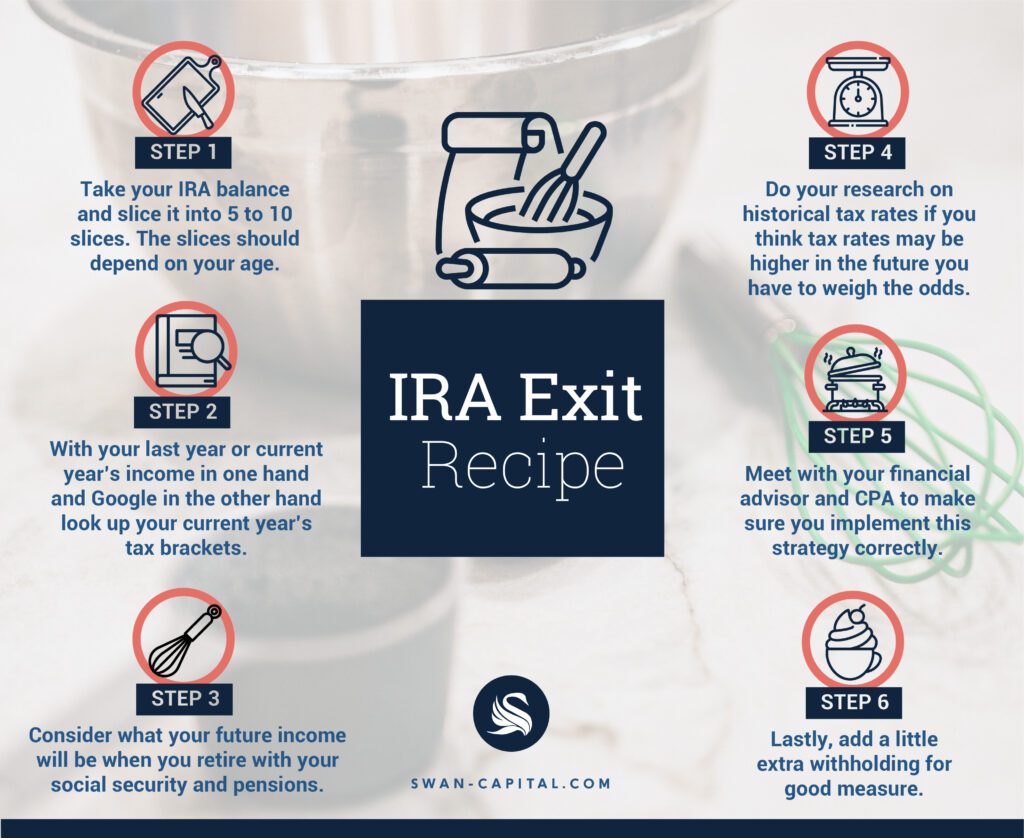Let me ask you one question: Do you think tax rates over the next decade will be headed higher or lower? If you’re like the thousands of individuals I have polled, you are most likely thinking higher. Of course, no one knows the future for sure, but based on the government’s spending habits and the current extremely high national debt, it makes sense to assume they may be higher. If this is true, how will it all impact you? It could matter a lot if you have one of these: Traditional IRA, SEP IRA, Simple IRA, Thrift Savings Plan (TSP), tax sheltered annuity (TSA), 403(b), 401(k), 457(b)…. the list could go on. You want to have a strategy for what you have spent a lifetime accruing.
We call it our IRA Exit Recipe: The recipe of unwinding a qualified plan, like an IRA, into a Roth IRA. The benefit of a Roth IRA is that it grows tax free, can be withdrawn tax free and transfer to your beneficiaries tax free. We help our clients methodically convert their traditional IRA to a Roth IRA while taxes are “on sale”. However, do keep in mind that a Roth conversion is a taxable event. Tax rates are “on sale” today because, historically speaking, they are very low. This may be a good time to pull off the Band-Aid and pay the impending lien on your IRA once and for all. Get your mixing bowl ready! Here is a hypothetical analogy to help understand how a Roth conversion works:
Step 1 – Slice an IRA balance into 5 to 10 slices. The number of slices should depend on the account owner’s age. Investors still working or under the age of 60 can take have more slices because they can convert their IRA over a longer period of time. They also don’t have to worry about Required Minimum Distributions (RMDs) until 72 years old, so they can start with 10 slices. People over age 65 or already taking RMDs may want to expedite the IRA Exit strategy with fewer slices.
Step 2 – With last year’s or the current year’s income in one hand and IRS.gov in the other, the account owner should look up the income range for his current year tax bracket. For example, if he makes $130,000 and the tax bracket ranges from $80,000 to $171,000, there is room for a potential $41,000 conversion that can be taxed at the same rate. These gaps in tax brackets are often a good window to consider for the “IRA EXIT Recipe”, or Roth Conversion.
Step 3 – The account owner should consider what his future income will be when he retires, including Social Security and pension benefits. He should compare his current income to his projected future income, and into which tax bracket his future retirement income will fall. We have found that for many of clients, their income will not drop as much as they once thought. They thought when they retired they would be in a lower tax bracket because they would have less income, but between RMDs, pensions and Social Security, they may be pretty close to what they were making when they worked fulltime.
Step 4 – Work with a tax professional to conduct research on historical tax rates to help determine if tax rates may be higher in the future. The plan owner must weigh the odds between paying taxes now, while he knows the rate, or take the gamble to see if rates will drop even lower in the future. History tells us the latter may not be wisest choice.
Step 5 – The plan owner should meet with his financial advisor and CPA to make sure this strategy is appropriate and implemented correctly. His advisor and CPA may have alternate recommendations that could work better for his financial scenario.
Step 6 – Lastly, add a little extra tax withholding for good measure. We know in the South that a dish can always use a little extra butter. Many families trying to do it themselves don’t withhold enough and develop a big tax surprise on April 15 of the following year because they didn’t withhold enough.
Many recipes are fun to attempt at home. DIY baking can be fun and even the mess can be sweet. However, when it comes to investment tax planning, sometimes it is easier to make a call for takeout and work with qualified professionals. Conversion from milliliters and ounces can be complicated and the same goes with Roth Conversions. If you have questions about this “recipe” and other tax strategies, give us a call and we will be happy to see if this strategy is a good fit for you.

Investment advisory services offered only by duly registered individuals through AE Wealth Management, LLC (AEWM) and/or Swan Capital. AEWM and Swan Capital are not affiliated companies. Our firm is not permitted to offer tax or legal advice. Please consult with a qualified professional regarding your individual situation. A Roth Conversion is a taxable event and may have several tax related consequences. Be sure to consult with a qualified tax advisor before making any decisions regarding your IRA. 645345 – 6/20
Thought this info was useful?
Please share it on your social media platforms!
Ready to Take the Next Step?
For more information about any of our products and services, schedule a meeting today or register to attend a seminar.
 Download this 8-page guide was created for you to better understand how taxes could affect your retirement income.
Download this 8-page guide was created for you to better understand how taxes could affect your retirement income.